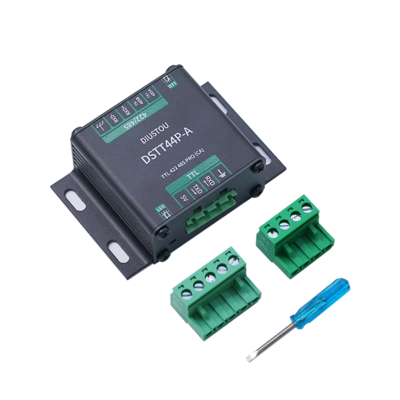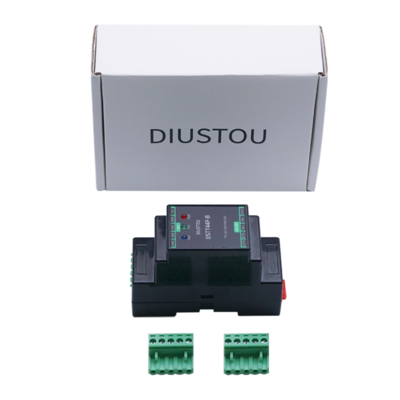Difference between revisions of "TTL 422 485 PRO"
From Diustou Wiki
Yousimaier17 (talk | contribs) (Created page with "{{Product |images=400px TTL 422 485 PRO (CA) ----- 400px TTL 422 485 PRO (CB) |categories= {{Categ...") |
Yousimaier17 (talk | contribs) |
||
| Line 22: | Line 22: | ||
|related= | |related= | ||
* [[RS232 TTL]] | * [[RS232 TTL]] | ||
| + | * [[USB TTL 232 485]] | ||
* [[USB TTL PLUS]] | * [[USB TTL PLUS]] | ||
* [[USB 232 PLUS]] | * [[USB 232 PLUS]] | ||
Revision as of 15:49, 5 February 2025
| ||||||||||||||||||||||
| ||||||||||||||||||||||
| ||||||||||||||||||||||
Contents
Product Overview
TTL 422 485 PRO (CA)
- Adopts original SP3485, with stable performance meeting industrial-grade design standards.
- This module enables mutual conversion between TTL signals and RS485/RS422 signals. The onboard automatic transmission and reception conversion circuit eliminates the need for "receive-transmit" control, enabling faster and more stable communication between the two interfaces.
- Utilizes a 5.08mm standard terminal block for smooth and secure plug-and-play connectivity.
- The circuit operates on a 5V power supply only, with TTL signal output at 5V (same as the supply voltage) and input signal level at 5V (compatible with 3.3V signal input).
- Power supply voltage must be connected to the TTL terminal when the module is in operation.
- Employs large-package components for enhanced stability and reliability.
- Features independent power and signal isolation circuits.
- The onboard digital isolator offers excellent performance characteristics and reliability, enabling signal isolation for more stable signal transmission.
- The onboard DC/DC power isolator provides a stable isolated voltage and output short-circuit protection, with no additional power supply required for the isolated end.
- The TTL terminal is equipped with overcurrent and surge protection functions, ensuring stable current and voltage output and strong impact resistance.
- The RS485/422 terminal includes overcurrent protection, surge protection, and lightning surge protection circuits.
- The onboard TVS (Transient Voltage Suppressor) effectively suppresses surge voltages and transient spike voltages in the circuit, protecting downstream circuits and equipment.
- The onboard self-resetting fuse ensures stable current and voltage output, prevents overcurrent, overvoltage, and electrostatic discharge, and has strong impact resistance.
- The onboard GDT (Gas Discharge Tube) can discharge powerful lightning currents into the ground, protecting subsequent circuits and equipment from surge damage.
- The board includes 120R termination resistor pads to enhance signal transmission stability and reduce interference.
- Baud rate support range:
- RS422: ≤2M bps (self-transmission and reception test, actual use should refer to the baud rate range of the connected devices)
- RS485: ≤2M bps (non-standard value, actual use should refer to the baud rate range of the connected devices)
- The board features two LED indicators to indicate the circuit signal operating status.
- TTL terminal indicator: Indicates TTL terminal receiving signals, i.e., when the signal flow is TTL -> 485/422, this LED blinks.
- 422/485 terminal indicator: Indicates TTL terminal sending signals, i.e., when the signal flow is 485/422 -> TTL, this LED blinks.
- Aluminum alloy housing with oxidized matte finish, precise cutouts, sturdy and durable, and exquisite craftsmanship.
TTL 422 485 PRO (CB)
- Adopts original SP3485, with stable performance meeting industrial-grade design standards.
- This module enables mutual conversion between TTL signals and RS485/RS422 signals. The onboard automatic transmission and reception conversion circuit eliminates the need for "receive-transmit" control, enabling faster and more stable communication between the two interfaces.
- Utilizes a 5.08mm standard terminal block for smooth and secure plug-and-play connectivity.
- The circuit operates on a 5V power supply only, with TTL signal output at 5V (same as the supply voltage) and input signal level at 5V (compatible with 3.3V signal input).
- Power supply voltage must be connected to the TTL terminal when the module is in operation.
- Employs large-package components for enhanced stability and reliability.
- Features independent power and signal isolation circuits.
- The onboard digital isolator offers excellent performance characteristics and reliability, enabling signal isolation for more stable signal transmission.
- The onboard DC/DC power isolator provides a stable isolated voltage and output short-circuit protection, with no additional power supply required for the isolated end.
- The TTL terminal is equipped with overcurrent and surge protection functions, ensuring stable current and voltage output and strong impact resistance.
- The RS485/422 terminal includes overcurrent protection, surge protection, and lightning surge protection circuits.
- The onboard TVS (Transient Voltage Suppressor) effectively suppresses surge voltages and transient spike voltages in the circuit, protecting downstream circuits and equipment.
- The onboard self-resetting fuse ensures stable current and voltage output, prevents overcurrent, overvoltage, and electrostatic discharge, and has strong impact resistance.
- The onboard GDT (Gas Discharge Tube) can discharge powerful lightning currents into the ground, protecting subsequent circuits and equipment from surge damage.
- The board includes 120R termination resistor pads to enhance signal transmission stability and reduce interference.
- Baud rate support range:
- RS422: ≤2M bps (self-transmission and reception test, actual use should refer to the baud rate range of the connected devices)
- RS485: ≤2M bps (non-standard value, actual use should refer to the baud rate range of the connected devices)
- The board features three LED indicators to indicate the circuit signal transmission and reception status.
- PWR light: Red, power indicator
- TXD light: Green, TTL data transmission indicator, data flow: RS422/485 -> TTL
- RXD light: Blue, TTL data reception indicator, data flow: TTL -> RS422/485
- Rail-mounted ABS eco-friendly housing, compact size, easy installation, and cost-effective.
Testing Methods
485 Testing
- Connect a USB-to-TTL serial module to the TTL port of the TTL 422 485 PRO module
- TXD - RXD
- RXD - TXD
- GND - GND
- Connect a USB-to-485 serial module to the 485 port of the TTL 422 485 PRO module
- A to A
- B to B
- Connect the power supply to the TTL terminal of the TTL 422 485 PRO module
- 5V - 5V
- GND - GND
- Connect the USB-to-TTL serial module and the USB-to-485 serial module to the computer, open two serial port debugging assistants, and select the corresponding port numbers.
- Use one of the serial port debugging assistants to send data to the TTL 422 485 PRO and observe if the receiving window of the other serial port assistant receives the same data as the sending end. If the data is the same, repeat the operation in reverse.
422 Self-Transmission and Reception Testing
- Connect a USB-to-TTL serial module to the TTL port of the TTL 422 485 PRO module
- TXD - RXD
- RXD - TXD
- GND - GND
- Short-circuit the pins of the USB 422 485 PRO module
- TXD+ to RXD+
- TXD- to RXD-
- Connect the power supply to the TTL terminal of the TTL 422 485 PRO module
- 5V - 5V
- GND - GND
- Connect the USB-to-TTL serial module to the computer, open the serial port debugging assistant, and select the corresponding port number.
- Use the serial port debugging assistant to send data to the TTL 422 485 PRO and observe if the receiving window of the serial port assistant receives the same data as the sending end.
Hardware Connection
Notes
- Power must be connected to the TTL terminal, and the power GND should be connected to the module's TTL terminal GND and the GND of the TTL device.
- TTL to 485: 485 is half-duplex communication. Although this module can achieve bidirectional communication, it cannot operate simultaneously in both directions; it must alternate. Even if UART is full-duplex communication, it cannot transmit and receive simultaneously; that is, each end of the communication channel can be a transmitting end or a receiving end, but at the same time, information can only flow in one direction.
- TTL to 422: 422 is full-duplex communication. This module can achieve simultaneous TTL and 422 signal transmission in both directions without interference, and transmission and reception do not require manual control, making it convenient and efficient.
- Fully consider the lightning protection and anti-interference design of the 485/422 interface. When transmitting over long distances in the field, connecting the module's "ground" terminal to the earth can provide excellent anti-interference and lightning protection, making 485/422 communication safer. For short-distance transmission indoors, grounding is not necessary.
Data Sheet
Resource Download
FAQ
|



